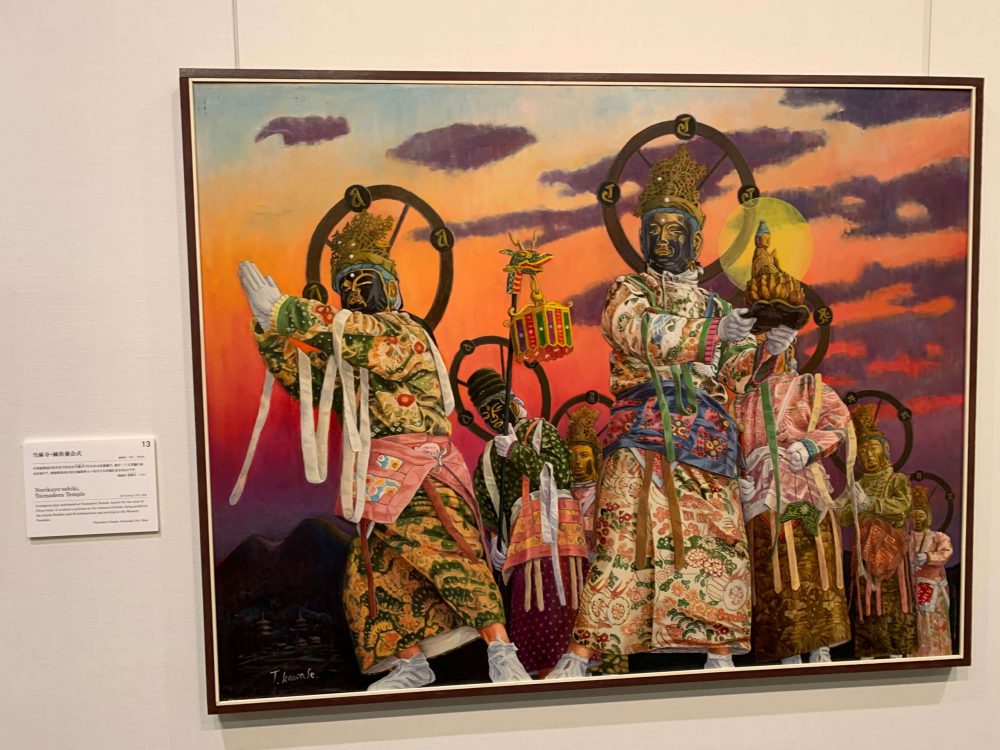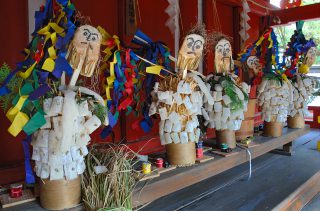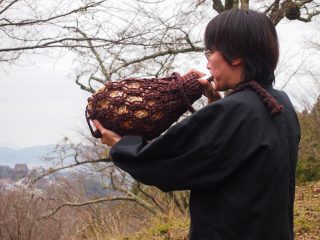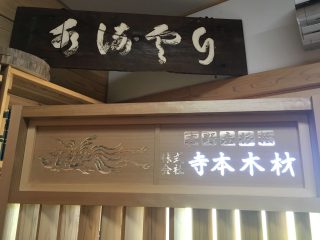Nara’s festivals are not boring!
Immediately after I entered the hall, a bright vermilion color came into my eyes.
It was a scene of a festival, with movement spreading across a large sketch that stood as tall as my height. It was an easy-to-understand, powerful picture.
My preconceived notion that, “festivals in Nara are plain and boring,” had vanished.
I was attending the “Nara’s Traditional Festivals and Events as Seen Through Paintings ” exhibition.
It was a painting exhibition that was held for about 3 months from December 2019 at the “Heijokyu Izanai-kan” Heijo Palace Site.
I was especially drawn to the highly detailed costume patterns in the painting. Each and every reflection of light within the complicated patterns and folds of the clothing depicted with realistic accuracy.
It must require so much patience to complete even one of these paintings!
There were 34 paintings on canvases larger than a tatami mat.
I was surprised that they were all done by just one person.

▲”Nara’s traditional festivals and events seen through paintings exhibition “Neri memorial service ceremony” at Taima-dera Temple

▲”Nara’s Traditional Festivals and Events as Seen Through Paintings” exhibition “Kawakami Festival” at Niu Kawakami Shrine in Higashi-yoshino Village
Festivals are held only once a year or every few years.Such pictures can’t be drawn without diving into the mountainous areas of Nara and observing these festivals first-hand with a discerning eye.
Why on earth was the painter so interested in these traditional festivals of Nara?
To answer this question, I talked directly with the painter himself, Mr. Kawase, and received an interview with him.
Enjoying his golden years
The painter of those works, Kawase Tadashi, is a 78-year-old man with a very gentle smile. He started to paint because he wanted to go on sketching field trips with his daughter, who was enrolled in an art university.
Having a background in mechanical design for work, he was already good at accurately drawing fine lines. From there, he gradually improved his painting skills as a hobby, and after retirement in his 60s, he began to work on festival paintings in earnest.

▲Many masterpieces of art can be found in his room. At that time, 34 more paintings were on display.
Nowadays, it is his daily routine to compose pictures by his bed so that his wife, who has some difficulty moving, does not get lonely.
He sometimes goes out, accompanied by his wife in a wheelchair, and attends ceremony parties.
Art seems to run in his family, as not only his daughter but also his four grandchildren also like to draw.

▲Mr. Kawase’s atelier. There are books, materials, and works of various sizes.
The reason Mr. Kawase focuses on paintings of festivals in Nara is that he wants to create pictures that are unique to him.
Originally, he was drawing landscape paintings, but when he started to focus on the theme of festivals in Nara, all his paintings won competitions.
Having won major awards such as the Prime Minister’s Award and the Yomiuri Shimbun Award, he learned how the richness of festivals in Nara touch people’s hearts, and he became more and more enthusiastic.

▲Painting of the Yamato Koriyama City Castle Festival “Period Parade” that he is currently working on
His current workplace is a room located on the first floor of his home that his wife can see when she is lying in bed.
Diversity that surprises the world
Two years before, he had a solo exhibition in Paris, taking his grandchild along as an interpreter.
In addition to new and reduced-sized works, he also published an art book. In France, he was able to hear direct feedback from overseas people for the first time.
The thing that attracted the most attention was the “brilliance of colors” used in his paintings. Another thing often commented on was “diversity.”
Although there are carnivals in France, there are few 1000-year-old festivals.
Compared to that, viewers were often surprised by the variety and depth of Japanese festivals that are unique in and of themselves.
“The French people said that they were really envious of the fact that there are still over 50,000 traditional events in various parts of Japan. They asked me how to see and participate in the festivals, but I couldn’t answer them. Traditional festivals have a limited number of days, so it is difficult for foreigners to visit or participate in them… Therefore, I recommended the ‘Kasuga Wakamiya Festival,’ where you can see the history of performing arts, and the “Heijo Palace site Tenpyo Festival”, where festival performances from all over Nara are held, since I thought it would be easier to see.”
As he expanded the field of activities overseas, it seems that his desire to help people know more about the festivals in Nara has grown stronger.
Painting from the heart
One of the characteristics of Mr. Kawase’s paintings is the large amount of information on display that allows people to see what is going on from just a glance. In this way, it seems as though the festival is condensed into a single picture.
He goes to a festival at least three times (that is, for three or more years), and takes many pictures to use to reconstruct scenes for his paintings.
In addition, he collects and reads books and materials related to the festivals of Nara, and incorporates history and people’s thoughts and perspectives on it all into his paintings.
Only then can he create a living picture.

▲In this painting of the “Kasuga Taisha Shrine Dance Performance”, he changed the stage setting to a lawn and thought carefully about the proper composition to suit the canvas.
“Now I’m particularly interested in the old, traditional dances that exist in festivals found in the backcountry areas of Yoshino. I have a feeling that I need to capture images of these festivals before they disappear.”
However, there are some things that can’t really be conveyed with painting.
One example is the “Kuzu-so” ceremony, which is held on the bank of the Yoshino River and is the continuation of 1300 years of history.
“By the clear stream of the Yoshino River, what you hear is the sound of silence, and then Japanese gagaku music played alongside spoken words to rejoice. You can feel the unique atmosphere of a slow and relaxed dance. On the approach, you can also see offerings such as Japanese parsley, dace, and a rare red frog. It is not possible to incorporate all of these elements into a painting. Therefore, I hope that my paintings can motivate people to go and see the event for themselves. I want them to experience the depths of the festival.”
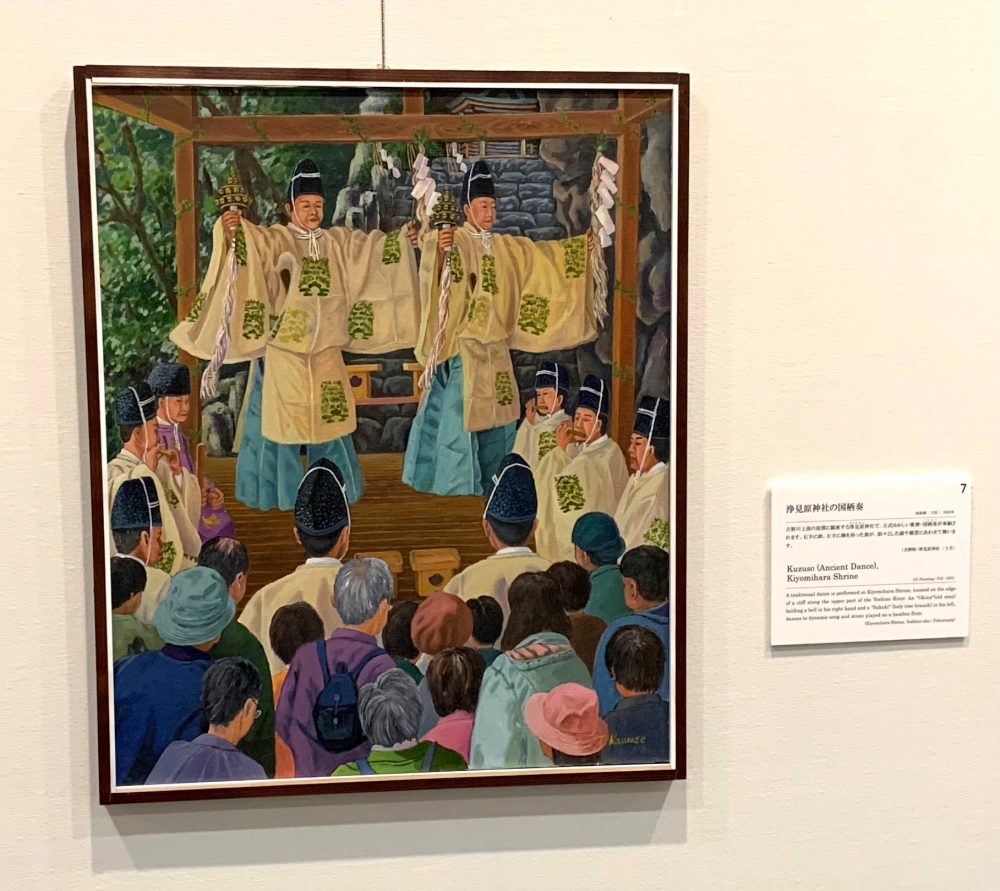
▲Dancing at “Kuzu-so” is performed solemnly in a clean place at Yoshino Kiyomihara Shrine
When I look at Mr. Kawase’s innocent smile, I think about my own life after retirement. While feeling proud to record and pass on the Japanese tradition, he continues to draw his favorite paintings, which deepens bonds with his family.
The festivals of Nara support such a way of life.
“Well now, I think I’ll follow Mr. Kawase’s example and search around for unique festivals in Nara as well!”
I left his house with a new determination of my own.

▲Some of the reference material for Mr. Kawase’s collection of works at a solo exhibition is in the upper left.
#nara #yoshino #tradition #festival #drawing #culture #matsuri #ceremony #heijo_palace_site #

